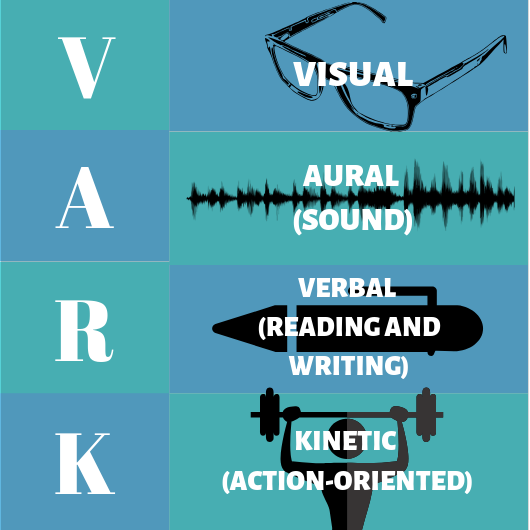Learning styles have risen in popularity over the last few years. It sounds very appealing. Some companies claim they can use learning styles to create a custom curriculum for each of your employees. This usually requires that you spend valuable resources on their very expensive tests to find out your employee’s learning styles.
Unfortunately, these claims can’t stand up to scientific studies on the subject, all of which boil down to one simple point: learning styles don’t exist.
What exactly is a “learning style?”
Supporters of learning styles claim that individuals respond better to specific instructional techniques. There are supposedly

over 70 learning styles that fall under VARK. VARK stands for:
- Visual
- Aural (sound)
- Verbal (reading and writing), and
- Kinetic (action-oriented).
Here are some examples of how these learning “styles” show up in our everyday lives.
Visual
Visual learning is just what it sounds like. It focuses on what you can see. A good example of visual learning is the emergency pamphlet that commercial airlines tuck into the pockets of the seats. They also force flight attendants to wave around detached belt buckles during demonstrations.
Aural (sound)
Let’s keep going with our airline theme.
An example of aural training is that voiceover that explains what the seatbelt-wielding flight attendant is trying to get across.
Verbal (reading and writing)
Verbal training is the description that goes along with the images from the pamphlet. They tell you helpful things, such as how the inflatable slides aren’t just for a quick dip in the ocean. They also make great boats!
Kinetic (action-oriented)
Now, I have yet to come across an airline who does this, but who knows.., they may exist somewhere. A safety training that was aimed at “kinesthetic” learners would let people practice escaping from a crashing plane.
How do people use VARK?
VARK is kind of like a barrel of monkeys. Any single style can combine with any other style to create a direct entry point to activate learning in an individual. Currently, VARK has over seventy combinations.
For example, someone who took a VARK test and came up as “kinetic-aural” would learn best in an action-oriented course with led by a facilitator or an eLearning course that played specific sound effects to reinforce actions. If you’ve ever heard of Pavlov or classical conditioning, this might be ringing a bell or two.
Dogged puns aside (last one I promise), if courses could genuinely be customized to the individual learner, then learning style-based courses would be the perfect solution. Unfortunately, this theory also suggests that a course designed to cater to a specific learning style such as kinetic-aural would be detrimental to another kind of learner.
This implies that VARK tactics are perfect for one-on-one training sessions. However, it also suggests that VARK methods in training that involves more than one learner would place vast quantities of employees at a learning disadvantage.
It is even more important to note that no peer-reviewed scientific research supports the existence of learning styles. In fact, research shows the opposite.
What does the science say?
Evidence suggests that what people have identified as learning styles is a reflection of learning preferences of one method of instruction over another. However, just because someone prefers using forks, that doesn’t make them the best tool for eating soup. Research confirms that courses that integrate multiple methods of instruction are more effective than courses that use only one or two styles. Studies show even those who prefer one “style” over another don’t rely solely on that “style” in their everyday life for personal learning. Experts have coined a new term replace learning styles— multiple intelligences.
What are ‘multiple intelligences’?
Multiple intelligences focus not on learner preference, but rather on learners’ cognitive abilities and how to engage the mind in more effective ways. Modern IQ tests identify what kind of information an individual is more capable of processing. For instance, if a facilitator hands identical twins the same test, one might score highly in logic, while the other might score highly in visual understanding. Courses that apply a multi-faceted approach prevents alienation of one or more intelligences over another and saves the time and money it takes to analyze your employees and customize your courses.
What does that mean for me?
Courses with more variety have a greater chance of moving information from your learners’ short-term memory into long-term storage. It also makes it more likely that the courses will engage your learners. A multi-faceted approach turns your employees from passive listeners into active participants. As a result, your employees will get more from your training, and you will get more from your employees. Don’t fall into the learning styles “honey trap.” Let MATC help you build training backed by proven scientific principles.
References
Learning Styles. (n.d.). Retrieved December 05, 2018, from https://teach.com/what/teachers-know/learning-styles/
Mcdaniel, R. (2018, May 07). Learning Styles. Retrieved December 05, 2018, from https://cft.vanderbilt.edu/guides-sub-pages/learning-styles-preferences/
Your Guide to Understanding and Adapting To Different Learning Styles. (n.d.). Retrieved December 05, 2018, from https://www.cornerstone.edu/blogs/lifelong-learning-matters/post/your-guide-to-understanding-and-adapting-to-different-learning-styles

